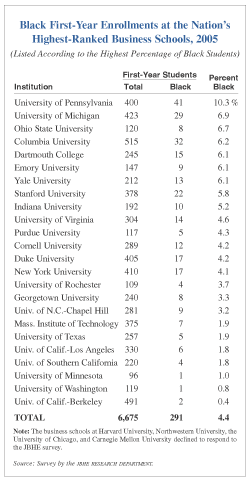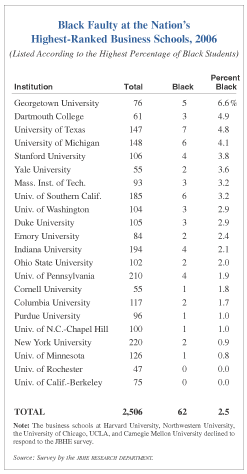| Black Admissions Are Lagging at the Nation's Leading Business Schools The nation's leading business schools are faltering in increasing the number of black students and black faculty.Among professional schools in the United States, the law and medical schools were the first to open their doors to African Americans. In recent years these graduate legal and medical programs continue to be active in recruiting and enrolling black students. But business schools in America have been major laggards. There are many explanations. One has to do with the history of racism in the United States. Due to Jim Crow, there was always a pressing need to educate black lawyers and black physicians because white practitioners did not want to deal with black clients or black patients. But for much of the history of our country there was no similar need for black business executives. Subtle racism prevailed. The business and banking establishments tended to view black people as unreliable, unintelligent, or incompetent either to manage money or function as managers of a business enterprise. Accordingly, separate law schools and medical schools were established for blacks in the nineteenth century, but there were no similar institutions at that time to train blacks in the field of business. A 1960 study of business school students conducted by Sterling Schoen, a white professor at the business school at Washington University in St. Louis, found at the time there was a total of about 12,000 students enrolled in MBA programs nationwide. Of these 12,000 MBA students, fewer than 50 were black. In other words, in the early 1960s blacks were 0.4 percent of the nation's students seeking MBAs.
Also, over the years business school deans and faculty tended to have little interest in racial and social issues. They were much less inclined than the law and medical school deans to introduce racial diversity into their schools. An example would be Dean Kim B. Clark who served as head of Harvard Business School in the 10 years from 1995 to 2005. Clark, a Mormon, often publicly stated his objectives for rebuilding the reputation of Harvard Business School. But he never spoke to the issue of racial diversity. Societal concerns did not appear to rank highly in his goals. Today greater diversity has occurred in the nation's MBA programs. Yet the black percentage of students enrolling at the nation's leading business schools still comes in far below the black percentage of enrollments at the nation's leading law and medical schools. This appears in part to be a reflection of the continuing perception of limited opportunities for blacks in high-level corporate management. Despite some remarkable breakthroughs in recent years such as Richard Parsons at Time Warner, Stanley O'Neal at Merrill Lynch, and Kenneth Chenault at American Express, African Americans still hold only a minuscule percentage of high-ranking corporate executive positions. Many high-achieving black college students see careers in law and medicine as paths they can take to achieve success and to �make a difference� in our society. But these same students see a far more difficult road ahead in trying to crack the �old-boy� network that still rules much of the banking, venture capital, and business culture of corporate America. The Status of Blacks at Leading Business Schools JBHE recently completed a survey of black first-year enrollments at the nation's 28 leading business schools. We received replies from 24 of the 28 schools. One school notable for its decision to decline to participate in our survey is Harvard Business School. The top-ranked Harvard Business School is a power center of American capitalism. An MBA from Harvard is perceived as a first-class ticket to the highest echelons of corporate America. Because of the high prestige of Harvard Business School, the progress of African Americans into and within the institution tends also to be an important measure of the progress of blacks in the world of business and finance. If other business educators at peer business institutions see that Harvard is striving to create a more racially diverse faculty and increase educational opportunities for black students, they are likely to adopt similar objectives. If, on the other hand, Harvard Business School pays scant attention to the task of integrating its faculty and student body, other business schools with poor records in hiring black faculty or recruiting black students will simply shrug off the issue and point to Harvard. Their defense will be, �Don't criticize our record. Look at the record of Harvard.� The fact that Harvard, unlike the vast majority of its peers, is unwilling to disclose the number of blacks students who are enrolled is, we suggest, a strong indicator that the business school has little commitment to racial diversity. For the 24 business schools that did respond to our survey, we found a total of 291 African-American first-year students enrolled in the MBA programs at these 24 high-ranking schools. The 291 black students entering business school last fall made up 4.4 percent of all entering students at these schools. The Wharton School at the University of Pennsylvania had the most black first-year students with 41. Columbia, the University of Michigan, and Stanford were the only other leading business schools that enrolled more than 20 first-year black students. Measured by the black percentage of the student body, Wharton again leads the pack. More than 10 percent of entering students at Wharton in 2005 were black. Blacks were at least 6 percent of their entering class at six other top business schools. These six business schools were at the University of Michigan, Ohio State University, Columbia University, Dartmouth College, Emory University, and Yale University. There was only one first-year black student at the business schools at the University of Minnesota and the University of Washington. Overall, there were seven leading business schools where blacks made up less than 2 percent of all first-year students. At the Haas School of Business at the University of California at Berkeley there were only two blacks among the 491 entering students in 2005. They made up only 0.4 percent of the first-year class. At the University of California at Los Angeles there were only six black students among the 330-member entering class. Clearly, the low level of black enrollments at these two business schools is due in large part to the ban on race-sensitive admissions in California imposed by the enactment of Proposition 209. Do the Nation's Top Business Schools Practice Race-Sensitive Admissions? JBHE asked the nation's leading business schools to supply information on the acceptance rate for all students and for black students only. A higher acceptance rate for black students compared to the overall student acceptance rate can be an indication, although not conclusive evidence, that a business school is practicing affirmative action in its admissions policies.
In JBHE's annual surveys of black freshmen at leading undergraduate colleges and universities we often find that the black student acceptance rate is considerably higher than the acceptance rate for all students. But at most of the nation's business schools there appears to be no preference for black applicants. Twelve of the nation's leading business schools provided JBHE with acceptance rates for black students and for the entire applicant pool. Only at Cornell University and Purdue University was the black student acceptance rate significantly higher than the rate for all students. Cornell accepted 53.7 percent of black applicants but only 34.4 percent of all applicants. At Purdue, the black student acceptance rate was 63.2 percent. Purdue accepted 49 percent of all applicants. At the other 10 business schools that supplied data, there was either little difference in acceptance rates or the black acceptance rate was significantly below the rate for all students. At the Haas School of Business at the University of California at Berkeley only three of the 25 black applicants were accepted for admission, a rate of 12 percent. Overall, 28 percent of all applicants to Haas were accepted. The publicly operated business school is prohibited by state law from considering race in its admissions decisions. At the University of Southern California, a private institution, the black acceptance rate was also 12 percent. The overall acceptance rate was 38 percent. Similar acceptance rates were found at Emory University, a private and well-regarded business school in Atlanta. At Ohio State University, the black acceptance rate was nearly 20 percentage points lower than the rate for all students. Black Faculty at the Nation's Leading Business Schools Our 2006 survey of the nation's leading business schools has identified 62 black professors at the 22 business schools that supplied data to the JBHE research department. These 62 black faculty members make up 2.5 percent of the total of 2,506 faculty members at these schools. In two previous JBHE surveys in 1999 and 2003, we found that blacks made up 2.7 percent of all faculty at the top business schools. Therefore, in the past several years there has been no progress in increasing the percentage of black faculty at the nation's leading business schools. In fact there has been a slight reduction in the percentage of black faculty at these schools. There are seven black faculty members at the business school at the University of Texas, the most of any of the business schools responding to our survey. There are six black faculty members at the business schools at both the University of Michigan and the University of Southern California. There are three black faculty members at the Sloan School of Management at the Massachusetts Institute of Technology. In our previous survey there were no blacks on the business school faculty at MIT. In 2006 there are no black faculty members at the business schools at the University of Rochester or the University of California at Berkeley. There is only one black faculty member each at the business schools at Purdue, Chapel Hill, Cornell, and the University of Minnesota. Georgetown University has the highest percentage of black faculty among the leading business schools. There the figure was 6.6 percent. At Dartmouth, the University of Texas, and the University of Michigan blacks make up at least 4 percent of the total faculty. At all of the other leading business schools, the black percentage of the faculty is below 4 percent. Fourteen of the 22 highest-ranked business schools in our survey have a black percentage of their total faculty that stands at 3 percent or less. At nine leading business schools blacks make up less than 2 percent of the total faculty. At New York University only two of the 220 faculty members are black. NYU is one of four leading business schools where blacks are less than one percent of the faculty. | |





